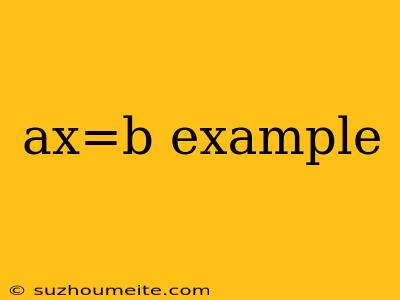Solving Linear Equations: Ax = b with Examples
In mathematics, specifically linear algebra, the equation Ax = b represents a fundamental concept. It describes a system of linear equations, where A is a matrix, x is a vector of unknowns, and b is a vector of constants. This article will explore what the equation represents, its applications, and how to solve it with examples.
Understanding Ax = b
- A: This is a matrix with coefficients that define the relationships between the unknowns in x.
- x: This is a vector containing the unknown variables that we aim to solve for.
- b: This is a vector containing the constant terms on the right-hand side of the equations.
Example:
Consider the following system of linear equations:
2x + 3y = 7
4x - y = 1
We can express this system in the form Ax = b as follows:
A = | 2 3 |
| 4 -1 |
x = | x |
| y |
b = | 7 |
| 1 |
Here, A represents the coefficients of the variables, x represents the unknown variables, and b represents the constants.
Applications of Ax = b
The equation Ax = b has wide-ranging applications in various fields, including:
- Engineering: Solving for forces in structures, analyzing circuits, and simulating systems.
- Computer Graphics: Representing transformations (rotation, translation, scaling) on objects.
- Economics: Modeling economic systems and analyzing market dynamics.
- Statistics: Performing regression analysis and solving for parameters in statistical models.
Methods for Solving Ax = b
Several methods exist for solving the equation Ax = b for the unknown vector x. Here are some common approaches:
1. Gaussian Elimination: This is a fundamental method that systematically transforms the augmented matrix [A | b] into an upper triangular form, allowing for easy back-substitution to find the solution.
2. LU Decomposition: This method decomposes the matrix A into a lower triangular matrix L and an upper triangular matrix U, such that A = LU. Solving for x then involves solving two simpler systems: Ly = b and Ux = y.
3. Inverse Matrix: If the matrix A is invertible, we can solve for x directly by multiplying both sides of the equation by A⁻¹:
x = A⁻¹b
4. Cramer's Rule: This method uses determinants to solve for each individual element of x. It is often less efficient for large systems but can be useful for solving for specific variables.
Example: Solving Ax = b using Gaussian Elimination
Let's solve the example system we defined earlier using Gaussian Elimination:
2x + 3y = 7
4x - y = 1
The augmented matrix is:
| 2 3 | 7 |
| 4 -1 | 1 |
We perform row operations to transform this matrix into upper triangular form:
- R2 = R2 - 2R1:
| 2 3 | 7 | | 0 -7 | -13 | - R2 = -R2/7:
| 2 3 | 7 | | 0 1 | 13/7 | - R1 = R1 - 3R2:
| 2 0 | 4/7 | | 0 1 | 13/7 |
Now, we have an upper triangular form. Solving by back-substitution:
- 2x = 4/7 => x = 2/7
- y = 13/7
Therefore, the solution to the system is x = 2/7 and y = 13/7.
Conclusion
The equation Ax = b plays a vital role in linear algebra and has numerous applications in various disciplines. Understanding the concept and methods for solving it is essential for anyone working with linear systems. Gaussian Elimination, LU decomposition, inverse matrix method, and Cramer's rule are common techniques that can be used to find the solution, with the choice depending on the specific problem and desired efficiency.
